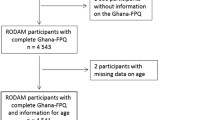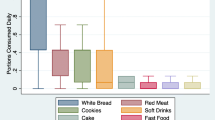Abstract
Purpose
As the French West Indies are facing an ongoing nutrition transition with increasing type-2 diabetes mellitus (T2DM) prevalence, our study aimed to evaluate the effect of potential shifts in dietary patterns on T2DM risk in French West Indian adults according to several scenarios.
Methods
We used a cross-sectional multistage sampling survey on dietary intake conducted in 2013 on a representative sample of Guadeloupeans and Martinicans adults (n = 1063). From previously identified current dietary patterns, we used PRIME-Diabetes, a comparative risk assessment model, to estimate the effect of potential shifts from the “transitioning” pattern to the “convenient,” the “prudent,” and the “traditional” ones on T2DM risks.
Results
Potential shift in dietary intakes from the “transitioning” pattern to the “traditional” one reduced the T2DM risk in women (− 16% [− 22; − 10]) and in men − 14% [− 21; − 7]), as the shift in dietary intakes toward the “prudent” pattern (− 23% [− 29; − 17] and − 19% − 23; − 14], respectively). These risk reductions were mostly driven by increased whole grains, fruits, green leafy vegetable intakes, and decreases in potatoes, red meats, processed meats, and sugar-sweetened beverages. The shift in dietary intakes toward the “convenient” pattern did not affect the T2DM risks.
Conclusion
To curb the increase in T2DM prevalence and reduce this burden, one public health action could be to target transitioning adults and help them to shift towards a diet associated with a reduced risk of T2DM as a prudent or a traditional diet.



Similar content being viewed by others
Data availability
Data described in the manuscript, codebook, and analytic code cannot be made available because they were provided by the French public health agency (Santé Publique France) and are not accessible to the public. Requests can be made to the French public health agency.
Abbreviations
- BMI:
-
Body mass index
- DASH:
-
Dietary approaches to stop hypertension
- DQI-I:
-
Diet quality index-international
- mPNNS-GS:
-
Modified programme national nutrition santé-guideline score
- PNNS-GS2:
-
Programme national nutrition santé-guideline score 2
- PRIME:
-
Preventable risk-integrated ModEl
- T2DM:
-
Type-2 diabetes mellitus
References
Institute for Health Metrics and Evaluation, Human Development Network, The World Bank (2013) The global burden of disease: generating evidence, guiding policy – Latin America and Caribbean regional edition. IHME, Seattle
Ferguson TS, Tulloch-Reid MK, Wilks RJ (2010) The epidemiology of diabetes mellitus in Jamaica and the Caribbean: a historical review. West Indian Med J 59:259–264
Boyne MS (2009) Diabetes in the Caribbean: trouble in paradise. Insulin 4:94–105. https://doi.org/10.1016/S1557-0843(09)80018-3
Pan American Health Organization (2019) NCDs at a glance: NCD mortality and risk factor prevalence in the Americas. PAHO, Washington
NCD Risk Factor Collaboration (NCD-RisC)—Americas Working Group (2019) Trends in cardiometabolic risk factors in the Americas between 1980 and 2014: a pooled analysis of population-based surveys. Lancet Glob Health 8:e123–e133. https://doi.org/10.1016/S2214-109X(19)30484-X
Zhou B, Lu Y, Hajifathalian K et al (2016) Worldwide trends in diabetes since 1980: a pooled analysis of 751 population-based studies with 4·4 million participants. Lancet 387:1513–1530. https://doi.org/10.1016/S0140-6736(16)00618-8
Ricci P, Blotière P-O, Weill A et al (2010) Diabète traité : quelles évolutions entre 2000 et 2009 en France ? Bull Épidémiologique Hebd BEH 7:425–431
Mandereau-Bruno L, Fosse-Edorh S (2017) Prévalence du diabète traité pharmacologiquement (tous types) en France en 2015. Disparités territoriales et socio-économiques. Bull Épidémiologique Hebd 2017:586–591
Popkin BM (2006) Global nutrition dynamics: the world is shifting rapidly toward a diet linked with noncommunicable diseases. Am J Clin Nutr 84:289–298
Sami W, Ansari T, Butt NS, Hamid MRA (2017) Effect of diet on type 2 diabetes mellitus: a review. Int J Health Sci 11:65–71
Popkin BM, Adair LS, Ng SW (2012) Global nutrition transition and the pandemic of obesity in developing countries. Nutr Rev 70:3–21. https://doi.org/10.1111/j.1753-4887.2011.00456.x
Colombet Z, Simioni M, Drogue S et al (2021) Demographic and socio-economic shifts partly explain the Martinican nutrition transition: an analysis of 10-year health and dietary changes (2003–2013) using decomposition models. Public Health Nutr. 23:1-12https://doi.org/10.1017/S136898002100327X. Epub ahead of print. PMID: 34551851.
Colombet Z, Allès B, Perignon M et al (2020) Caribbean nutrition transition: what can we learn from dietary patterns in the French West Indies? Eur J Nutr. https://doi.org/10.1007/s00394-020-02317-x
PARM (2019) Quels comportements et quelles opportunités d’innovations alimentaires ? Première étude de caractérisation du marché Antilles-Guyane
DAAF Guadeloupe, DEAL (2021) DIAG’Alim—Diagnostic du système alimentaire en Guadeloupe
Renzella J, Townsend N, Jewell J et al (2018) What national and subnational interventions and policies based on mediterranean and nordic diets are recommended or implemented in the WHO European region, and is there evidence of effectiveness in reducing noncommunicable diseases? WHO Regional Office for Europe, Copenhagen
Willcox DC, Willcox BJ, Todoriki H, Suzuki M (2009) The Okinawan diet: health implications of a low-calorie, nutrient-dense, antioxidant-rich dietary pattern low in glycemic load. J Am Coll Nutr 28(Suppl):500S-516S. https://doi.org/10.1080/07315724.2009.10718117
Willett W, Rockström J, Loken B et al (2019) Food in the anthropocene: the EAT-lancet commission on healthy diets from sustainable food systems. Lancet Lond Engl 393:447–492. https://doi.org/10.1016/S0140-6736(18)31788-4
Scarborough P, Harrington RA, Mizdrak A et al (2014) The preventable risk integrated ModEl and its use to estimate the health impact of public health policy scenarios. Scientifica 2014:748750. https://doi.org/10.1155/2014/748750
Adjibade M, Mariotti F, Leroy P et al (2021) Impact of intra-category food substitutions on the risk of type 2 diabetes: a modelling study on the pizza category. Br J Nutr. https://doi.org/10.1017/S0007114521002130
Castetbon K, Ramalli L, Vaidie A et al (2016) Consommations alimentaires et biomarqueurs nutritionnels chez les adultes de 16 ans et plus en Guadeloupe et Martinique. Enquête Kannari 2013–2014. Bull Épidémiologique Hebd 4:52–62
Colombet Z, Perignon M, Salanave B et al (2019) Socioeconomic inequalities in metabolic syndrome in the French West Indies. BMC Public Health 19:1620. https://doi.org/10.1186/s12889-019-7970-z
World Health Organization (WHO) Expert Committee (1995) Physical status: the use and interpretation of anthropometry. Report of a WHO Expert Committee. World Health Organ Tech Rep Ser 854:1–452
Le Moullec N, Deheeger M, Preziosi P et al (1996) Validation du manuel-photos utilisé pour l’enquête alimentaire de l’étude SU.VI.MAX. Cah Nutr Diététique 31:158–164
Arnault N, Caillot L, Castetbon K et al (2013) Table de Composition des aliments NutriNet-Santé. Edition Économica, Paris
Haubrock J, Nöthlings U, Volatier J-L et al (2011) Estimating usual food intake distributions by using the multiple source method in the EPIC-potsdam calibration study. J Nutr 141:914–920. https://doi.org/10.3945/jn.109.120394
Black AE (2000) Critical evaluation of energy intake using the Goldberg cut-off for energy intake:basal metabolic rate. A practical guide to its calculation, use and limitations. Int J Obes Relat Metab Disord J Int Assoc Study Obes 24:1119–1130
Mifflin MD, St Jeor ST, Hill LA et al (1990) A new predictive equation for resting energy expenditure in healthy individuals. Am J Clin Nutr 51:241–247
Allès B, Samieri C, Féart C et al (2012) Dietary patterns: a novel approach to examine the link between nutrition and cognitive function in older individuals. Nutr Res Rev 25:207–222. https://doi.org/10.1017/S0954422412000133
Baudry J, Touvier M, Allès B et al (2016) Typology of eaters based on conventional and organic food consumption: results from the NutriNet-Santé cohort study. Br J Nutr 116:700–709. https://doi.org/10.1017/S0007114516002427
Schwingshackl L, Hoffmann G, Lampousi A-M et al (2017) Food groups and risk of type 2 diabetes mellitus: a systematic review and meta-analysis of prospective studies. Eur J Epidemiol 32:363–375. https://doi.org/10.1007/s10654-017-0246-y
Jannasch F, Kröger J, Schulze MB (2017) Dietary patterns and type 2 diabetes: a systematic literature review and meta-analysis of prospective studies. J Nutr 147:1174–1182. https://doi.org/10.3945/jn.116.242552
Qian F, Liu G, Hu FB et al (2019) Association between plant-based dietary patterns and risk of type 2 diabetes: a systematic review and meta-analysis. JAMA Intern Med. https://doi.org/10.1001/jamainternmed.2019.2195
Kesse-Guyot E, Chaltiel D, Fezeu LK et al (2021) Association between adherence to the French dietary guidelines and the risk of type 2 diabetes. Nutrition 84:111107. https://doi.org/10.1016/j.nut.2020.111107
Schulze MB, Martínez-González MA, Fung TT et al (2018) Food based dietary patterns and chronic disease prevention. BMJ 361:k2396. https://doi.org/10.1136/bmj.k2396
Neuenschwander M, Ballon A, Weber KS et al (2019) Role of diet in type 2 diabetes incidence: umbrella review of meta-analyses of prospective observational studies. BMJ 366:l2368. https://doi.org/10.1136/bmj.l2368
Waijers PMCM, Feskens EJM, Ocké MC (2007) A critical review of predefined diet quality scores. Br J Nutr 97:219–231. https://doi.org/10.1017/S0007114507250421
Jiang T, Shuai X, Li J et al (2020) Protein-bound anthocyanin compounds of purple sweet potato ameliorate hyperglycemia by regulating hepatic glucose metabolism in high-fat diet/streptozotocin-induced diabetic mice. J Agric Food Chem 68:1596–1608. https://doi.org/10.1021/acs.jafc.9b06916
Shih C-K, Chen C-M, Varga V et al (2020) White sweet potato ameliorates hyperglycemia and regenerates pancreatic islets in diabetic mice. Food Nutr Res. https://doi.org/10.29219/fnr.v64.3609
Luo D, Mu T, Sun H (2021) Sweet potato (Ipomoea batatas L.) leaf polyphenols ameliorate hyperglycemia in type 2 diabetes mellitus mice. Food Funct 12:4117–4131. https://doi.org/10.1039/d0fo02733b
Méjean C, Debussche X, Martin-Prevel Y et al (2020) Food and nutrition in the French overseas regions. IRD Éditions, coll. Expertise collective, Marseille
Sobers-Grannum N, Murphy MM, Nielsen A et al (2015) Female gender is a social determinant of diabetes in the Caribbean: a systematic review and meta-analysis. PLoS ONE 10:e0126799. https://doi.org/10.1371/journal.pone.0126799
Guariguata L, Brown C, Sobers N et al (2018) An updated systematic review and meta-analysis on the social determinants of diabetes and related risk factors in the Caribbean. Rev Panam Salud Publica Pan Am J Public Health 42:e171. https://doi.org/10.26633/RPSP.2018.171
Acknowledgements
The authors thank the Martinique health observatory (OSM), the Guadeloupe health observatory (Orsag), the regional health agency of Martinique (ARS-Martinique), the regional health agency of Guadeloupe (ARS-Guadeloupe), the French Agency for Food, Environmental and Occupational Health and Safety (Anses) and the French Public Health Agency (Santé Publique France), as the main investigators, promoters, and supporters of the Escal and Kannari surveys. The authors thank the interviewers and all the participants. The authors also thank the Nutritional Surveillance and Epidemiology Team (ESEN), French Public Health Agency and Paris-13 University, as the main investigator of the nutritional part of the surveys and for access to the Escal and Kannari databases and support documentation.
Funding
This study was part of the NuTWInd project (Nutrition Transition in French West Indies), supported by the French National Research Agency (Agence nationale de la recherche, ANR) in the context of the 2016 “appel à projets générique” (ANR-16-CE21-0009).
Author information
Authors and Affiliations
Contributions
The authors’ responsibilities were as follows: CM and LGS designed the study, ZC drafted the manuscript, ZC performed the statistical analysis, PL performed the PRIME-Diabetes model, ZC, PL, CM and LGS contributed to the data interpretation and revised each draft for important intellectual content. All authors read and approved the final manuscript.
Corresponding author
Ethics declarations
Conflict of interest
The authors declare that they have no conflict of interest.
Supplementary Information
Below is the link to the electronic supplementary material.
Rights and permissions
Springer Nature or its licensor (e.g. a society or other partner) holds exclusive rights to this article under a publishing agreement with the author(s) or other rightsholder(s); author self-archiving of the accepted manuscript version of this article is solely governed by the terms of such publishing agreement and applicable law.
About this article
Cite this article
Colombet, Z., Leroy, P., Soler, LG. et al. Shifts in dietary patterns and risk of type-2 diabetes in a Caribbean adult population: ways to address diabetes burden. Eur J Nutr 62, 2233–2243 (2023). https://doi.org/10.1007/s00394-023-03144-6
Received:
Accepted:
Published:
Issue Date:
DOI: https://doi.org/10.1007/s00394-023-03144-6




